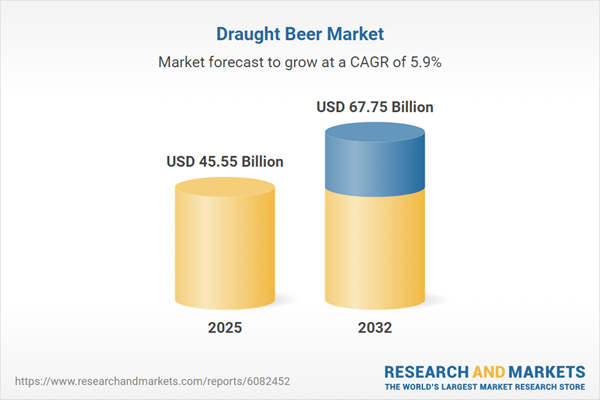Speak directly to the analyst to clarify any post sales queries you may have.
The draught beer market is experiencing a dynamic period of transformation, shaped by evolving technologies, changing consumer preferences, and strategic shifts across the supply chain. Senior decision-makers require clear, actionable intelligence to understand the implications of these changes on production, distribution, and growth opportunities.
Market Snapshot: Draught Beer Market Overview
The Draught Beer Market grew from USD 42.98 billion in 2024 to USD 45.55 billion in 2025 and is projected to maintain robust momentum at a CAGR of 5.85%, reaching USD 67.75 billion by 2032. New investments and innovation trajectories are expected to further enhance product quality and market penetration in established and emerging regions. As distribution channels become more diversified and consumer engagement deepens, the sector remains resilient to shifting global beverage trends.
Scope & Segmentation
This report delivers an in-depth examination of the draught beer market, offering comprehensive segmentation insights to guide strategic planning:
- Beer Types: Ale (Amber, Brown, IPA, Pale); Lager (Dunkel, Helles, Pilsner); Stout (Dry, Imperial, Milk, Oatmeal); Wheat (American Wheat, Hefeweizen, Witbier).
- Keg Sizes: Half Keg, Mini Keg, Quarter Keg, Sixth Barrel, Slim Quarter.
- Sales Channels: Bars and Pubs, Events and Festivals (Fairs, Exhibitions, Music Festivals), Hotels and Resorts, Restaurants, Sports and Entertainment Venues (Arenas, Race Tracks, Stadiums).
- Alcohol Content Levels: Premium, Standard, Super Premium.
- Regional Coverage: Americas (United States, Canada, Mexico, Brazil, Argentina, Chile, Colombia, Peru), Europe, Middle East & Africa (United Kingdom, Germany, France, Russia, Italy, Spain, Netherlands, Sweden, Poland, Switzerland, United Arab Emirates, Saudi Arabia, Qatar, Turkey, Israel, South Africa, Nigeria, Egypt, Kenya), Asia-Pacific (China, India, Japan, Australia, South Korea, Indonesia, Thailand, Malaysia, Singapore, Taiwan).
- Leading Enterprises: Anheuser-Busch InBev SA/NV, Heineken N.V., China Resources Beer, Carlsberg A/S, Molson Coors, Asahi Group Holdings, Tsingtao Brewery, Kirin Holdings, Constellation Brands, Sapporo Holdings.
Key Takeaways for Senior Decision-Makers
- Integration of advanced brewing and dispensing technologies is streamlining operations and enhancing product consistency throughout the value chain.
- Data-driven and digital engagement initiatives are enabling direct connections with consumers, supporting agile product development and refined marketing strategies.
- Sustainability is reshaping operational priorities, with breweries investing in water-saving, lightweight packaging and closed-loop systems to meet regulatory and consumer expectations.
- Segment differentiation—by beer type, keg size, and channel—enables targeted portfolio management and drives brand relevance across distinct regions and demographics.
- Collaboration among large brands, regional brewers, and technology partners fosters knowledge transfer, supply chain resilience, and accelerated time to market for innovations.
Tariff Impact on the Draught Beer Market
Recent tariff policies introduced in 2025 have altered the landscape for ingredient procurement and equipment imports, prompting brewers and distributors to revisit supplier agreements, reconfigure logistics, and seek alternative sourcing. Resulting adaptations include asset lifecycle extensions, increased maintenance, and ongoing value engineering to mitigate cost inflation without compromising on product quality or service standards.
Methodology & Data Sources
Research for this report leverages a triangulated approach, including stakeholder interviews with brewers, distributors, and retail operators, secondary reviews of industry literature, field observations in production and taproom settings, and survey data capturing consumer attitudes. Quantitative findings undergo statistical validation, while qualitative inputs are synthesized through content and theme analysis, further corroborated by industry workshops.
Why This Report Matters
- Enables senior leaders to benchmark performance and uncover actionable growth opportunities in a fast-evolving draught beer market.
- Supplies granular segmentation, regional, and channel intelligence to support data-driven strategy development and investment decisions.
- Equips stakeholders to respond proactively to regulatory, operational, and consumer-driven shifts, ensuring long-term competitiveness and resilience.
Conclusion
The complex landscape of the draught beer sector requires strategic agility and rigorous insight. This report distills essential information for forward-focused decision-making and positions stakeholders to capitalize on innovation and emerging market dynamics.
Table of Contents
3. Executive Summary
4. Market Overview
7. Cumulative Impact of Artificial Intelligence 2025
Companies Mentioned
The companies profiled in this Draught Beer market report include:- Anheuser-Busch InBev SA/NV
- Heineken N.V.
- China Resources Beer (Holdings) Company Limited
- Carlsberg A/S
- Molson Coors Beverage Company
- Asahi Group Holdings, Ltd.
- Tsingtao Brewery Company Limited
- Kirin Holdings Company, Limited
- Constellation Brands, Inc.
- Sapporo Holdings Limited
Table Information
| Report Attribute | Details |
|---|---|
| No. of Pages | 186 |
| Published | November 2025 |
| Forecast Period | 2025 - 2032 |
| Estimated Market Value ( USD | $ 45.55 Billion |
| Forecasted Market Value ( USD | $ 67.75 Billion |
| Compound Annual Growth Rate | 5.8% |
| Regions Covered | Global |
| No. of Companies Mentioned | 11 |









